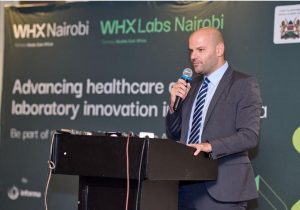New Report Urges Sustainable Solutions to Address Medical Oxygen Shortages in LMICs


- In March 2021, the Ministry of Health in Kenya reported that oxygen availability in public health facilities was low, at 16%.
Spurred by the COVID-19 pandemic, some of the world’s leading producers of medical liquid oxygen took steps – or pursued ad-hoc initiatives – to expand access to their lifesaving product in some of the low- and middle-income countries (LMICs) experiencing critical oxygen shortages during the global health crisis. However, the underlying, longstanding problem of a persistent lack of access to medical oxygen in LMICs remains largely unaddressed. A new report from the Access to Medicine Foundation analyses what gas companies have done so far to tackle this inequity and identifies tangible actions they can take to expand access to medical liquid oxygen over the long term.
- Many medical facilities in LMICs do not have reliable access to medical oxygen, which is a lifesaving treatment for a wide array of diseases, such as pneumonia and tuberculosis. It is also essential for daily medical procedures, for example during surgery and childbirth.
- This new report from the Access to Medicine Foundation looks at access efforts from six of the world’s largest global gas companies that also produce medical liquid oxygen: Air Liquide, Air Products, Linde, Messer, Nippon Sanso Holdings Corporation and SOL Group.
- Standout examples of company action, especially during the COVID-19 pandemic, are identified in the report – as are opportunities to harness this momentum.
Better access to medical oxygen is urgently needed
According to a recent survey of emergency care centres across Kenya, over 30% of the facilities did not have a regular supply of oxygen. Given that medical oxygen is included in the World Health Organization’s Model List of Essential Medicines, the issue is urgent, and on a vast scale. In 2021, it was estimated that 73 million people with low blood oxygen (hypoxemia) attended healthcare facilities in LMICs, and of those, only 22 million were suffering from COVID-19. Many more people, including 32 million children, attending these facilities needed oxygen due to other conditions and routine procedures, for example if they were undergoing anesthesia during surgery.
Yet, all too often, these healthcare facilities in LMICs did not have – and still do not have – adequate supplies of medical oxygen to treat their patients, leading to preventable loss of life. Approximately half of healthcare facilities in LMICs do not have reliable access to medical oxygen. This is despite the fact that medical oxygen is included in the World Health Organization’s Model List of Essential Medicines, meaning it is a product that should be available in every country’s health system.
A key role for gas companies
Given the essential nature of medical oxygen, and the fact that just a handful of gas companies produce the vast majority of the global supply of medical liquid oxygen, it is critical to the wellbeing of people living in low- and middle-income countries (LMICs) that these companies scale up access to this product as a priority. In Kenya, a report published in 2020 by the Ministry of Health, recommended the need to scale-up medical oxygen availability in public primary hospitals as oxygen availability was higher in privately owned facilities and secondary hospitals.
“With a small number of companies responsible for the world’s supply of medical liquid oxygen, the role they play in the global health ecosystem needs to be prioritised. Medical gases are a small part of these companies’ business, yet society needs them to ensure this vital lifeline is available both during emergencies and to meet the daily medical oxygen needs of all health systems.” – Jayasree K. Iyer, CEO, Access to Medicine Foundation.
In analysing companies’ initiatives to date, the Foundation has identified some agile responses from the six major gas companies in scope – Air Liquide, Air Products, Linde, Messer, Nippon Sanso Holdings Corporation and SOL Group – to increase the supply of medical liquid oxygen* in an attempt to meet demand surges caused by the COVID-19 pandemic. These companies now have the opportunity to further pursue long-term access planning to secure sustainable supply beyond this global health crisis.
Access to medical oxygen needs to become a corporate priority for these major gas companies – with company leadership driving this change. Prioritizing LMICs in their business operations will not only help achieve this vital health mission but can position gas companies to expand their businesses to markets that have been largely underserved.
Six priority areas for company action
Based on analysis of the issue and what actions have been taken so far, the report identifies six priority areas for action that companies can focus on to provide access to medical liquid oxygen in LMICs, both in emergencies and to provide routine delivery. Each area is explored in depth to include examples of what companies are currently doing, as well as recommendations for what companies can do to better address access.
- Prioritise, measure and report progress on medical liquid oxygen
- Enable improved affordability for different populations and health systems
- Provide sustainable supply of medical liquid oxygen
- Develop and maintain long-term partnerships to close access gaps
- Support health systems and the human resources required to operate and maintain medical liquid oxygen systems and administer oxygen therapy
- Plan proactively for future emergencies
This urgent global health priority cannot be resolved until gas companies further commit to, and take action on, expanding and sustaining long-term access to the lifesaving product they produce.
“Some of the companies in scope have demonstrated the steps they are taking to improve access over the long term, but clearer commitments are required. The priority areas for action set out in this report show gas companies what they can do to prioritise and invest in LMICs, be proactive in finding new ways of increasing supply, and engage in long-term sustainable approaches to access.” – Johann Kolstee, Research Programme Manager, Access to Medicine Foundation
What have companies done so far?
The examples outlined in the report show that, particularly in response to COVID-19, some gas companies took steps to address the access issue – from airlifting whole medical liquid oxygen tankers and trailers into LMICs via specially chartered aircrafts, to pivoting more production capacity from industrial liquid oxygen to much-needed medical liquid oxygen. However, these efforts were limited in geographic reach. Across the six major gas companies covered by this analysis, initiatives to increase the supply of medical liquid oxygen during the COVID-19 pandemic have been reported, publicly or directly to the Foundation, in only 39 of the 108 LMICs in scope – approximately one third.
Moreover, now that the immediate public health emergency has passed, it is not always clear whether companies will continue to address gaps in access in LMICs over the long term.
Of the companies examined in the report, Air Liquide is currently the only company with a clear access-to-medical oxygen strategy targeting LMICs. Air Products, Linde, Messer, Nippon Sanso Holdings Corporation and SOL Group are also taking some steps in the right direction, with broad commitments to health but with no specific targets related to medical oxygen or LMICs.
The report identifies some efforts from companies that could lead to a more sustainable supply of medical LOX in more LMICs over the long term. Since the start of the COVID-19 pandemic, for example, both Air Liquide and Linde have reported providing medical LOX in regions they did not previously supply. Encouragingly, Air Liquide, Air Products, Messer and Nippon Sanso Holdings Corporation have reported the installation or acquisition of new liquid oxygen-producing Air Separation Units (ASUs), including in South Africa, China, Egypt, India, Vietnam and Thailand. These ASUs have the potential to significantly boost supply of medical liquid oxygen.
There are several challenges to improving access to medical oxygen in LMICs, including healthcare facility infrastructure and a fragmented supply chain involving complicated logistics and distribution networks. However, the gas companies in scope of this report can play a critical role in helping to overcome some of these challenges, in particular by pursuing and formalising long-term partnerships with governments and global health stakeholders. Air Liquide and Linde have already formalised partnerships with global health organisations to address access gaps in LMICs, with both companies entering into Memoranda of Understanding (MoUs) with Unitaid and the Clinton Health Access Initiative (CHAI).
With the publication of this report, the Foundation calls for gas companies to further pursue progress and be proactive in finding new ways of increasing supply and engage in long-term sustainable approaches to access. In this way, they can help ensure people in all countries have access to medical oxygen, when they need it.



